Essential Asphalt Shingle Roofing Maintenance
TL;DR: Asphalt shingles dominate American roofs due to affordability and versatility, but they need regular maintenance to remain effective. Inspection and upkeep, addressing issues like missing or damaged shingles, moss, and algae, are crucial for longevity. Professional help is recommended for thorough inspections and major repairs, ensuring your roof remains sturdy and protects your home.
Almost 64% of all American houses have asphalt shingle roofs. That makes it the most used roofing material in the U.S. and with good reason. Asphalt shingles are affordable, versatile, and easy to install, making them a go-to choice for when you want to balance cost with quality.
Despite their robustness, asphalt shingles demand regular attention to keep protecting your house effectively. Essential asphalt shingle roofing maintenance is about regular upkeep and prevention.
Ignoring these maintenance tasks can result in different types of damage and decrease your home’s energy efficiency. Regular upkeep keeps the roof effectively shielding your home from weather damage, leaks, and other potential hazards. This article will give you some maintenance tips to keep your asphalt shingle roofing in good condition.
The Basics of Asphalt Shingle Roofing
Asphalt shingles are made from fiberglass or felt paper base coated in waterproof asphalt and topped with ceramic granules. This composition makes them highly effective against water intrusion, earning them a spot as one of the most popular roofing choices in the U.S.
As already mentioned, asphalt shingles are affordable and easier to install than other roofing materials. They come in many colors and styles to suit any home’s architecture – from classic to modern. Their cost-effectiveness doesn’t mean a compromise on protection, though. When properly installed, they provide a reliable shield against the elements, contributing to their widespread use.
Lifespan and Durability
Another factor that makes asphalt shingles so widely used is their durability. The typical life expectancy of asphalt shingle roofs is between 20 to 50 years. Several factors play pivotal roles in either shortening or extending the life of your roof, including:
- Weather. Areas prone to severe weather conditions, like hail storms, heavy snowfall, or extreme temperatures, have a reduced lifespan in roofing materials. Shingles can crack, loosen, or even blow off under harsh weather conditions, leading to more frequent repairs or replacements.
- Quality of Installation. A roof installed by a professional, following all manufacturer guidelines and building codes, stands a better chance at a long lifespan. Poor installation can lead to leaks and cracks, compromising the roof’s integrity.
- Roof Ventilation. Proper ventilation keeps the attic space near the same temperature as the outside air, reducing the risk of freezing in winter and too much heat in summer. Both extremes can damage asphalt shingles from beneath.
- Regular Maintenance. Upkeep involves keeping gutters clean, removing debris, and doing minor repairs. Neglecting your roof can lead to preventable damage, while consistent maintenance can spot potential problems and damage on a larger scale.
Regular Inspection and Maintenance
You should schedule inspections during the spring and fall. These semi-annual check-ups prevent normal wear and tear from escalating into expensive, hard-to-fix disrepairs.
When inspecting your roof, try to look for:
- Missing Shingles. Bare spots can expose your roof to excess moisture and leaks. This damage affects the roofing structure and makes it easy for water to infiltrate your home.
- Curling Shingles. Deformation of the shingles indicates they’re close to wearing out. Curling can allow water to seep underneath, damaging the roof deck below.
- Cracking Shingles. This is another symptom of aging shingles or weather damage that can leave your roof vulnerable to water ingress.
Dealing with Moss and Algae
Moss can retain moisture against the roof surface, which can degrade the shingles, while algae can cause dark patches and streaks across the roof. To combat these issues, you can use a 50% water and 50% bleach mixture to kill the moss or algae. After 15 to 20 minutes, gently wash away the solution with a low-pressure water hose. Avoid using a pressure washer because it can damage the shingles.
Immediate Actions for Common Issues
When you own a home, it’s practically a given you’ll face some roofing issues. Common problems can range from minor leaks to significant damage after a storm. However, knowing how to handle these can save your roof and your wallet from more trouble.
Damaged or Missing Shingles
Ignoring these issues can lead to leaks, damaging the inside and outside of your house. You should look out for cracks, curls, or missing granules. To replace damaged or missing shingles, you need a sturdy ladder and proper footwear to prevent slips. Once you’re up there:
- Lift the shingle directly above the damaged one with a flat pry bar to remove the nails.
- Once you’ve removed the nails, you can pull out the damaged shingle.
- Place a new shingle and nail it down with roofing nails so it blends with the other shingles.
- Apply a small amount of roofing cement on the nail heads to seal them and prevent any future leaks.
Proper Ventilation
Without ventilation, moisture can build up under your shingles, leading to mold, rot, and structural damage. That makes sense when you consider that hot air rises and, without a place to escape, it will condense and settle, creating an ideal environment for moisture problems. Improving airflow can be as simple as adding roof vents or ensuring that existing ones aren’t blocked.
Cleaning Gutters Regularly
They may not seem directly related to your roof, but their health is vital to keeping your roofing system in good shape. Overflowing water will damage the roof and seep into the siding and foundation. The excess weight can also cause gutters to pull away from the roof and rip out a few shingles.
Professional Maintenance and When to Seek Help
Unlike a quick check you might do yourself, a professional can spot issues that could easily escape untrained eyes. They look beyond the obvious, checking for subtle signs of wear, potential leaks, and areas where water might pool and cause damage over time. This level of inspection ensures that minor issues get addressed on time, extending the life of your roof.
Professional roofers understand the specific needs of asphalt shingle roofing, including the right materials for repairs, the best repair techniques, and how to ensure your roof meets all relevant building codes and standards.
Major Repairs and Roof Replacement
Knowing when the time for major repairs or replacing your asphalt shingle roofing has come can be tricky, but there are some clear signs to watch for. If your roof has multiple leaks, missing shingles, or visible sagging, these are strong indicators that work is needed.
If your roof is approaching the end of its lifespan, it’s probably time to replace it. A complete roof replacement will address existing issues and allow you to upgrade your roofing materials for better performance and durability.
A professional will guide you through the selection of materials so you can choose shingles that match your climate needs and personal preferences while staying within your budget.
Have the Best Asphalt Shingles Roof in Fort Myers, Florida
The condition of your asphalt shingle roof directly influences the safety and longevity of your entire home. Regular maintenance can stop smaller issues from becoming major ones.
You must strike a balance between personal upkeep efforts and seeking the expertise of professional roofers. You can handle some tasks yourself, but leave the rest in the capable hands of Boss Roofing Experts in Fort Myers, Florida.
Our roofers are qualified inspectors who can give you a full report on the state of your roof. They’ll advise you on your next step and give you fair prices for any service. Don’t leave yourself without a roof over your head; get in touch with us today!



